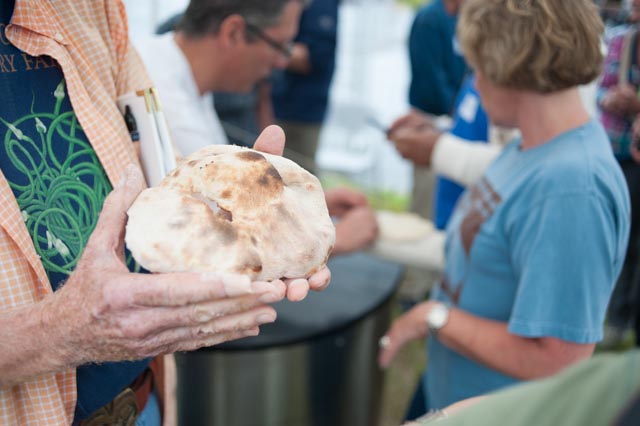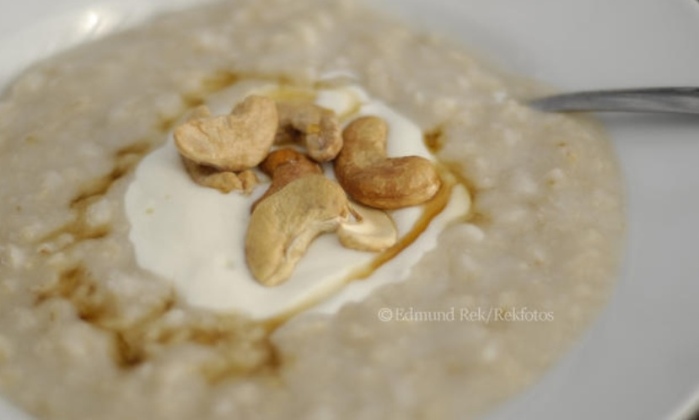>
We rely on our friends and family for many things and as new small business owners, sometimes we cross the line. Like the time our daughter, 2 at the time, ran around the Brick Works farmers market with a t-shirt that read: “Evelyn’s Crackers, we put the crack in crackers.”
(photo (c)2008 Edmund Rek)
Quickly becoming infamous with the last minute call for baby-sitting mostly by friends, as our family are in the States, every once and while someone will come to the kitchen and help with cracker production, as did Naomi:
On Tuesday afternoon I did a short shift with Dawnthebaker at the Incubator Kitchen making crackers for Evelyn’s Crackers (named after fabulous Evelyn, Dawn and Ed’s three=year=old daughter). The crackers are hand-made, truly made by hand. The dough is mixed by machines, then divided into pieces which are hand-shaped, then run, piece by piece, through a sheeter, a machine like a pasta-maker that squeezes it flat. Each sheet of dough on its individual piece of parchment paper is stacked on the last and then when the stack is high, it’s put aside to chill while the rest of the dough is flattened. At this stage we’re not nearly halfway in the hand-work.
The chilled sheets come back out and then once again, one by one, are put carefully through the sheeter, now set to a thinner setting. They double in area (and fragility too, of course). Once again, after all the sheets in the stack have been run through the sheeter and then restacked, the stack gets set aside in the cooler while the remaining stacks are run through.
Then it’s time for the final pre-baking hand-work: Sheet by sheet the crackers are cut. You take the pizza-cutter-like roller and run it in straight lines down the dough, trying to space them evenly and keep them straight. For the cheese crackers that we were making there were six or seven lines vertically and about 11 horizontally per baking sheet of dough. No wonder Dawn feels her wrists get tired! I felt it more in my back, because the work is assymetrical, when you bend sideways over the sheet to do the cross-wise cuts.
After each sheet is cut into crackers, it is pulled over onto the stack of already sliced dough. Once the stack is tall, it is covered with plastic, tightly sealed, and frozen. The baking will take place next day or sometime in the next week. And baking too means handling the crackers sheet by sheet, putting them into the oven, and then taking them out and leaving them on a rack to cool and crisp up.
Now that all sounds long, doesn’t it? And yet it’s just a description, with no details, really.
Dawn does all this physical labour with grace and strength and skill. Sometimes Ed is there working with her, or a less-skilled sidekick like me, but most often she’s there on her own, either making and shaping crackers, or else baking.
When we were there together, she could get crackers baked while I shaped (and she was often over helping with the shaping process in between baking chores). The lovely scent of her Barley Noir crackers perfumed the space as we worked, and the spicy Dal Crackers too added their aroma when they were baked.
The thing about the cracker production, the thing that is valuable (apart from the fact that they are made from local and organic ingredients, and that they taste wonderful and are a treat to eat), is the hand-made-ness. It creates an entirely different cracker population. They are NOT all the same. For though each batch is made from one dough, the fact that they are rolled out and cut by hand, sheet by sheet, cut by cut, means that the crackers each have a personality and clear identity. There’s kind of a “every snowflake is unique” quality to them.
So while the goal of industrial production and chain restaurants is complete consistency and uniformity, the goal of hand-crafted anything, from crackers, to clothing, to furmiture, to home-cooking, is individual distinctiveness within a recognisable form. That’s why we love home-made food. And that’s what we lose if we buy “food” that has been extruded and cut and shaped by highly industrial processes.
People say, but this is elitist, this emphasis on the hand-crafted; processed food is cheaper. But it’s not. Home-made food, each of us starting with basic ingredients at home, is the least expensive and best. Next in line is food made by someone we know, made with care and attention. And as we tried to emphasise in our book HomeBaking, let’s not, as home cooks, start to think that our food should look like food that is made by machine, all “perfect” and predictable. Let’s treasure the unpredictable, the individual, the idiosyncratic.
(written by Naomi Duguid, cookbook author and one of the best reasons to live in Toronto/her blog/her website)






















